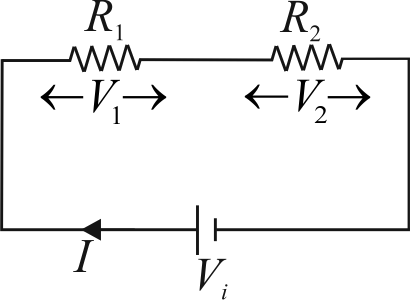Explanation:
The situation is shown in the circuit diagram.

Current flowing through the circuit,
\(\,\,\,\,\,\,\,\,\,\,\,\,\,\,\,\,\,\,\,\,\,I = \frac{{{V_i}}}{{{R_1} + {R_2}}}\)
Voltage across \({R_2},{V_2} = I{R_2}\)
\(\,\,\,\,\,\,\,\,\,\,\,\,\,\,\,\,\,\,{V_2} = \frac{{{V_i}{R_2}}}{{{R_1} + {R_2}}}\,\)
\( \Rightarrow \,\,\,\,\frac{{{R_1} + {R_2}}}{{{R_2}}} = \frac{{{V_i}}}{{{V_2}}}\)
\( \Rightarrow \,\,\,\,\,\,\,\,{\kern 1pt} \frac{{{V_i}}}{{{V_2}}} = \frac{{{R_1} + {R_2}}}{{{R_2}}}\)